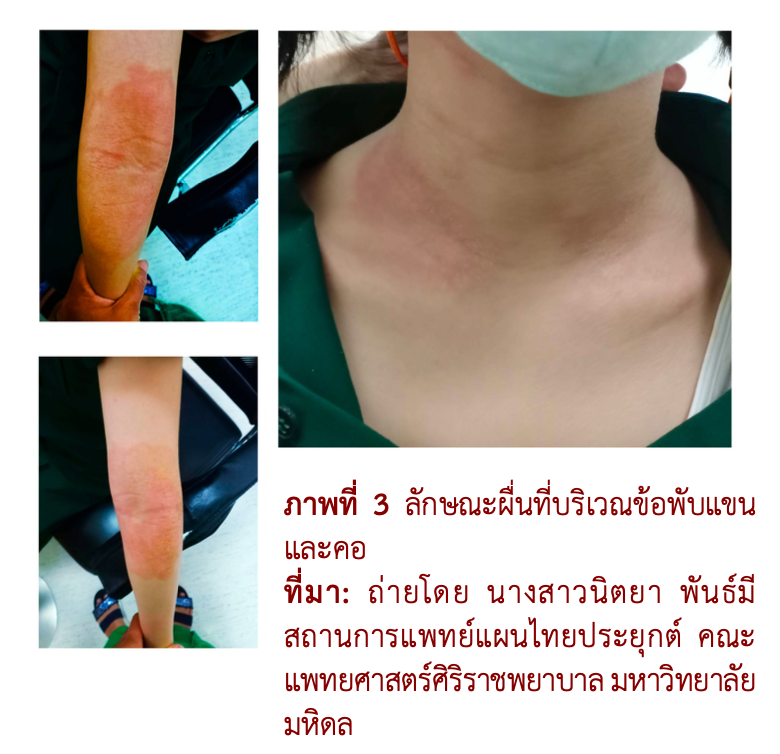An Overview of The Treatment of pruritus in Thai Traditional Medicine and Traditional Chinese Medicine
Main Article Content
Abstract
The most prevalent symptom of skin problem is pruritus. It could be caused by skin pathology or other disorders. In western medicine, tropical treatments are typically used for dermatological conditions or medical conditions associated with underlying disorders. Traditional medicine is utilized as an alternative or comple- mentary therapy, including Thai traditional medicine (TTM) and Traditional Chinese Medicine (TCM). This article provides an overview of the most prevalent pruritus in TTM and TCM. The four elements of earth, water, wind, and fire were used to evaluate TTM theoretically. TCM considers the five elements of wood, fire, earth, metal, and water in its conceptual analysis. TTM and TCM both investigated abnormalities in body elements and created treatment plans. The herbal treatment is personalized to the body elements of each patient. This comparative perspective could broaden traditional medicine's knowledge. This could be applied to clinical practice or re- search in the future, allowing patients to be referred to each other or to a western medicine specialist.
Article Details

This work is licensed under a Creative Commons Attribution-NonCommercial-NoDerivatives 4.0 International License.
References
Tivoli YA, Rubenstein RM. Pruritus: an updated look at an old problem. J Clin Aesthet Dermatol 2009;2(7):30-36.
Moses S. Pruritus. Am Fam Physician 2003;68(6):1135-1142.
ผู้จัดการโรงเรียนเวชสโมสรรัตนโกสินทร์. เวชศึกษา แพทยศาสตร์สังเขป เล่ม 1, 2, 3. พระยาพิศณุประสาทเวช; 2451.
พระยาพิศณุประสาทเวช. แพทย์ศาสตร์สงเคราะห์ เล่ม 1. กรุงเทพฯ : โรงพิมพ์ไทย; 2452.
พระยาพิศณุประสาทเวช. แพทย์ศาสตร์สงเคราะห์ เล่ม 2. กรุงเทพฯ : โรงพิมพ์ศุภการจำรูญ; 2450.
ประกาศคณะกรรมการพัฒนาระบบยาแห่งชาติ เรื่อง บัญชียาหลักแห่งชาติ พ.ศ. 2563. ราชกิจจานุเบกษา. เล่ม 137 ตอนพิเศษ 254 ง, หน้า 3.
โรงเรียนแพทย์แผนโบราณวัดพระเชตุพนวิมลมังคลาราม ราชวรมหาวิหาร. ตำราประมวลหลักเภสัช. กรุงเทพฯ; 2528.
Ying XH. TCM syndrome differentiation and treatment of Skin pruritus. Journal of Navy medicine 2005;26(2): 138.
Chen HF, editors. External medicine of Traditional Chinese Medicine. 2rd ed. Shanghai: Shanghai Science and Technology Press; 2009.
Chen XR, editors. Intergrated Traditional Chinese and Western Medicine in treatment of skin disease. Beijing: People’s Medical publishing house;2012.
Yang HM, Xu J, Yang G, Zheng c. Discussion on the relationship between the skin pruritus pathogenesis and syndrome differentiation and treatment in TCM. Chin J Dermato Venerol Integ W Med 2006;5(3):175-181.
Liu XT, He Y, Zhang JH, He CH, A preliminary study on the mechanism of skin pruritus and the correlation between TCM syndrome differentiation and treatment. Med J chin PAP 2021;32(4):362-364.
Jiang YS. TCM syndrome differentiation and treatment of itchy skin. Chinese Journal of information on TCM 2013;20(6):93-94.
กรมพัฒนาการแพทย์แผนไทยและการแพทย์ทางเลือก. ตำรับยาจีนที่ใช้บ่อยในประเทศไทยฉบับสมบูรณ์.กรุงเทพฯ: โรงพิมพ์ชุมนุมสหกรณ์การเกษตรแห่งประเทศไทย; 2554.
Deng ZJ, editors. Prescription of Traditional Chinese Medicine. 4th ed. Beijing: China Traditional Chinese Medicine Publishing; 2012.






